Birdfinding.info ⇒ The Greater Antillean endemic form of the American Barn Owl appears to be fairly common overall, but difficult to find except by chance or at a known roost or nest site. On Jamaica, it has been found throughout the island, including Kingston and the grounds of various seaside hotels; perhaps most consistently at Robins Bay. On Grand Cayman, it is most often reported from the George Town area. On Cuba, it has been found at all of the frequently visited sites, perhaps most often at Playa Larga and Cayo Coco.
“White-winged Barn Owl”
Tyto furcata furcata
Endemic to the western West Indies: Cuba, the Isle of Youth, Jamaica; and the Cayman Islands. Occurs mainly in open and semiopen habitats, including agricultural and urban areas. Roosts and nests in caves and undisturbed enclaves of buildings.
May also wander to the Bahamas, where the continental “American Barn Owl” is known to occur. The presence of “White-winged” there has not been confirmed, but recent photos from San Salvador (March 25, 2018) and Grand Bahama (October 25, 2019) appear consistent with this form.
Identification
The largest barn owl in the Americas, with extensively white or buffy wings and tail—i.e., both undersides and uppersides.
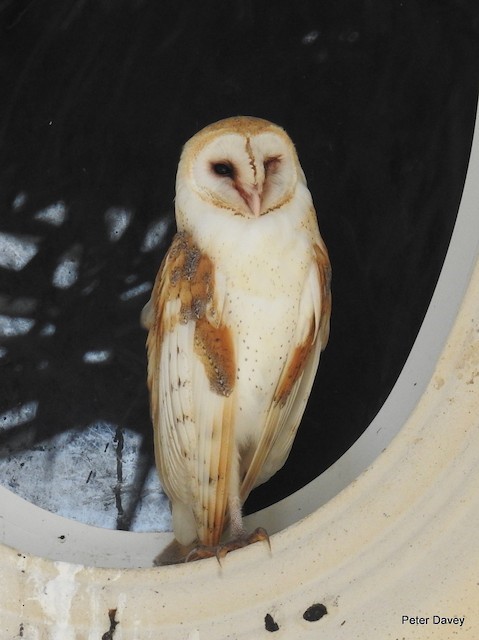
“White-winged Barn Owl,” T. f. furcata, male. (Patricks Island, Grand Cayman; May 9, 2017.) © Peter Davey
The apparent large size of its body and wings often makes its head appear proportionately small.
The coloration of the plumage varies somewhat—as in other barn owls, males are generally paler than females.
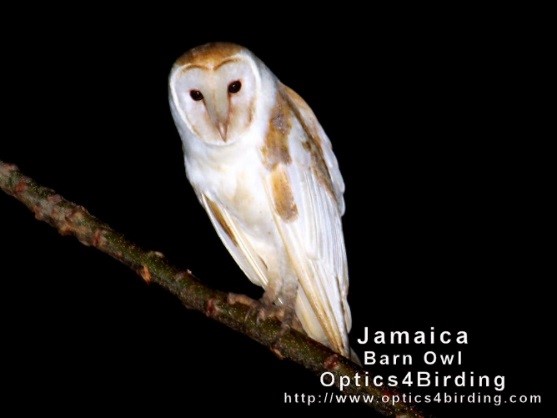
“White-winged Barn Owl,” T. f. furcata, male with pure white secondaries and inner primaries. (Ecclesdown Road, Jamaica; July 2014.) © Dan Lockshaw
On most individuals, the uppersides of the flight feathers and tail are mostly whitish or pale buffy with gray spots—but on some males, all the flight and tail feathers can appear pure white.
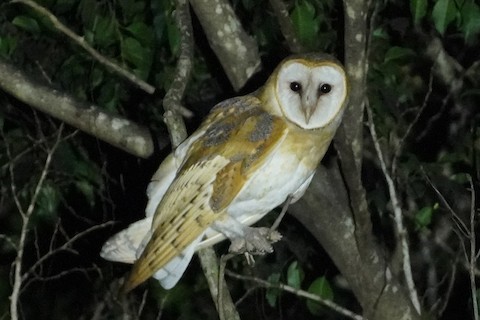
“White-winged Barn Owl,” T. f. furcata, sex undetermined. (Anchovy Gardens, Jamaica; March 28, 2023.) © Emily Hjalmarson
On some individuals—presumably females—the flight and tail feathers can appear mostly buffy with large dark spots, making them difficult to distinguish from the widespread “American Barn Owl” (which occurs at least occasionally in Cuba).
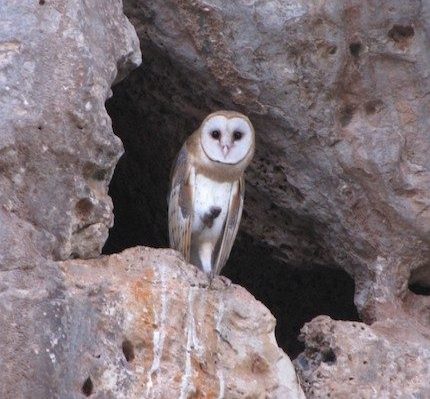
“White-winged Barn Owl,” T. f. furcata, likely female, with buffy, heavily spotted flight feathers and contrastingly dark chest. (Bucanero, Santiago de Cuba, Cuba; March 22, 2011.) © Jean Boulva
Voice. Calls of the “White-winged Barn Owl” generally resemble those of other barn owls but, judging from the publicly accessible recordings, appear to be somewhat softer and less harsh than the corresponding calls of the widespread “American Barn Owl”. The typical call is a fairly soft rasp (sandpapery scraping noise), often repeated frequently and at length:
The male’s territorial call is a scream—which, in this recording at least, appears notably clear compared to other barn owl screams:
Notes
Monotypic form, one of four potentially distinct forms of the American Barn Owl (T. furcata). A second subspecies, niveicauda, endemic to the Isle of Youth, was formerly recognized.
More Images of the “White-winged Barn Owl”
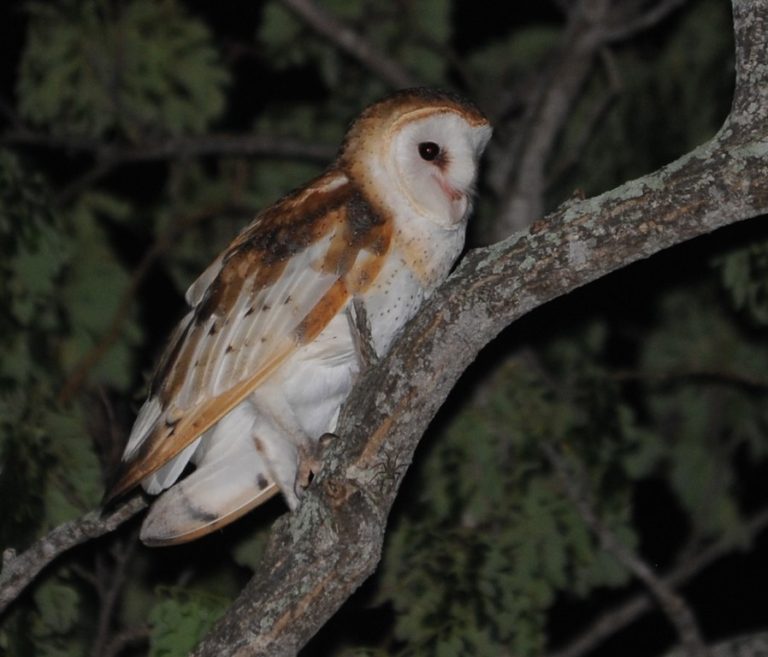
“White-winged Barn Owl,” T. f. furcata. (Green Castle Estate, Jamaica; November 5, 2013.) © Alan Van Norman

“White-winged Barn Owl,” T. f. furcata. (Belén, Cuba; December 28, 2010.) © Christian Artuso
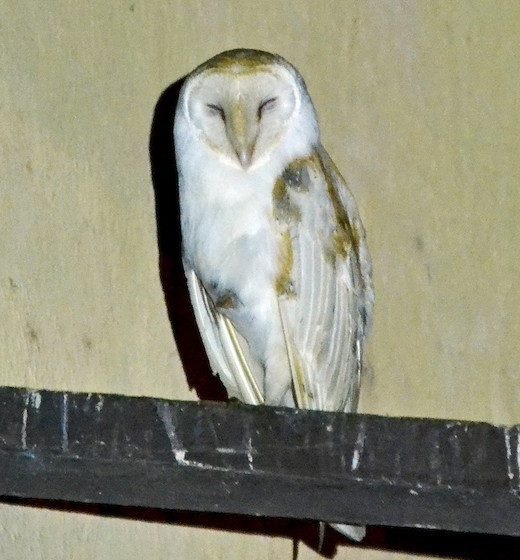
“White-winged Barn Owl,” T. f. furcata, with pure white secondaries. (Remedios, Villa Clara, Cuba; January 19, 2016.) © Michael J. Good

“White-winged Barn Owl,” T. f. furcata, likely female, with buffy, heavily spotted flight feathers. (Golden Grove, Jamaica; April 15, 2014.) © Gil Ewing
References
Aliabadian, M., N. Alaei-Kakhki, O. Mirshamsi, V. Nijman, and A. Roulin. 2016. Phylogeny, biogeography, and diversification of barn owls (Aves: Strigiformes). Biological Journal of the Linnean Society 119:904-918.
BirdLife International. 2019. Tyto alba (amended version of 2016 assessment). The IUCN Red List of Threatened Species 2019: e.T22688504A155542941. https://dx.doi.org/10.2305/IUCN.UK.2019-3.RLTS.T22688504A155542941.en. (Accessed September 18, 2023.)
eBird. 2023. eBird: An online database of bird distribution and abundance. Cornell Lab of Ornithology, Ithaca, N.Y. http://www.ebird.org. (Accessed September 18, 2023.)
Enríquez, P.L., K. Eisermann, H. Mikkola, and J.C. Motta-Junior. 2017. A Review of the Systematics of Neotropical Owls (Strigiformes), Neotropical Owls: Diversity and Conservation (P.L. Enríquez, ed.). Springer International Publishing, Cham, Switzerland.
Garrido, O.H, and A. Kirkconnell. 2000. Field Guide to the Birds of Cuba. Cornell University Press, Ithaca, N.Y.
Haynes-Sutton, A., A. Downer, R. Sutton, and Y.-J. Rey-Millet. 2009. A Photographic Guide to the Birds of Jamaica. Princeton University Press, Princeton, N.J.
iNaturalist. 2023. https://www.inaturalist.org/. (Accessed September 18, 2023.)
König, C., and F. Weick. 2008. Owls of the World (Second Edition). Yale University Press.
Mikkola, H. 2013. Owls of the World: A Photographic Guide (Second Edition). Firefly Books, London.
Raffaele, H., J. Wiley, O. Garrido, A. Keith, and J. Raffaele. 1998. A Guide to the Birds of the West Indies. Princeton University Press, Princeton, N.J.
Xeno-Canto. 2023. American Barn Owl – Tyto furcata. https://xeno-canto.org/species/Tyto-furcata. (Accessed September 18, 2023.)
